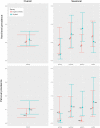British Escherichia coli O157 in Cattle Study (BECS): to determine the prevalence of E. coli O157 in herds with cattle destined for the food chain
- PMID: 28925340
- PMCID: PMC9148770
- DOI: 10.1017/S0950268817002151
British Escherichia coli O157 in Cattle Study (BECS): to determine the prevalence of E. coli O157 in herds with cattle destined for the food chain
Abstract
Escherichia coli O157 are zoonotic bacteria for which cattle are an important reservoir. Prevalence estimates for E. coli O157 in British cattle for human consumption are over 10 years old. A new baseline is needed to inform current human health risk. The British E. coli O157 in Cattle Study (BECS) ran between September 2014 and November 2015 on 270 farms across Scotland and England & Wales. This is the first study to be conducted contemporaneously across Great Britain, thus enabling comparison between Scotland and England & Wales. Herd-level prevalence estimates for E. coli O157 did not differ significantly for Scotland (0·236, 95% CI 0·166-0·325) and England & Wales (0·213, 95% CI 0·156-0·283) (P = 0·65). The majority of isolates were verocytotoxin positive. A higher proportion of samples from Scotland were in the super-shedder category, though there was no difference between the surveys in the likelihood of a positive farm having at least one super-shedder sample. E. coli O157 continues to be common in British beef cattle, reaffirming public health policy that contact with cattle and their environments is a potential infection source.
Keywords: Escherichia coli (E. coli) O157; Bovine; epidemiology; estimating disease prevalence.
Figures

References
-
- Karmali MA, et al. The association between idiopathic haemolytic uremic syndrome and infection by verotoxin-producing Escherichia coli. The Journal of Infectious Diseases 1985; 151: 775–782. - PubMed
-
- Willlshaw GA, et al. Verocytotoxin-producing Escherichia coli (VTEC) O157 and other VTEC from human infections in England and Wales: 1995–1998. Journal of Medical Microbiology 2001; 50: 135–142. - PubMed
-
- Trevena WB, et al. Transmission of Vero cytotoxin producing Escherichia coli O157 infection from farm animals to humans in Cornwall and west Devon. Communicable Disease and Public Health 1999; 2: 263–268. - PubMed
Publication types
MeSH terms
Grants and funding
LinkOut - more resources
Full Text Sources
Other Literature Sources
Medical
Miscellaneous

